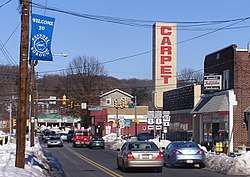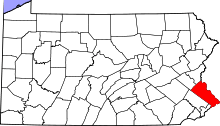Penndel, Pennsylvania
| Borough of Penndel | |
|---|---|
| Borough | |
 Downtown Penndel, Pennsylvania | |
 Location of Penndel in Bucks County, Pennsylvania. | |
 Penndel Location of Penndel in Pennsylvania  Penndel Penndel (the US) | |
| Coordinates: 40°09′22″N 74°54′51″W / 40.15611°N 74.91417°WCoordinates: 40°09′22″N 74°54′51″W / 40.15611°N 74.91417°W | |
| Country | United States |
| State | Pennsylvania |
| County | Bucks |
| Founded | 1899 |
| Government | |
| • Mayor | Bob Winkler |
| Area[1] | |
| • Total | 0.42 sq mi (1.08 km2) |
| • Land | 0.42 sq mi (1.08 km2) |
| • Water | 0.00 sq mi (0.00 km2) |
| Elevation | 105 ft (32 m) |
| Population (2010) | |
| • Total | 2,328 |
| • Estimate (2016)[2] | 2,200 |
| • Density | 5,263.16/sq mi (2,033.38/km2) |
| Time zone | UTC-5 (Eastern (EST)) |
| • Summer (DST) | UTC-4 (EDT) |
| ZIP code | 19047 |
| Area code(s) | 215 and 267 |
| FIPS code | 42-58936 |
| Website | http://www.penndelboro.com |
Penndel is a borough in Bucks County, Pennsylvania, United States. The population was 2,328 at the 2010 census.
Geography
Penndel is located at 40°9′22″N 74°54′51″W / 40.15611°N 74.91417°W (40.156109, -74.914050).[3]
According to the United States Census Bureau, the borough has a total area of 0.4 square miles (1.0 km2), all of it land.
Demographics
| Historical population | |||
|---|---|---|---|
| Census | Pop. | %± | |
| 1900 | 377 | — | |
| 1910 | 514 | 36.3% | |
| 1920 | 557 | 8.4% | |
| 1930 | 789 | 41.7% | |
| 1940 | 921 | 16.7% | |
| 1950 | 1,100 | 19.4% | |
| 1960 | 2,158 | 96.2% | |
| 1970 | 2,686 | 24.5% | |
| 1980 | 2,703 | 0.6% | |
| 1990 | 2,703 | 0.0% | |
| 2000 | 2,420 | −10.5% | |
| 2010 | 2,328 | −3.8% | |
| Est. 2016 | 2,200 | [2] | −5.5% |
| Sources:[4][5][6] | |||
In 2014, the borough was estimated to be 72.4% Non-Hispanic White, 15.3% Black or African American, 2.3% Asian, 2.1% none of the former, and 2.6% were two or more races. 11.8% of the population were of Hispanic or Latino ancestry.[7]
As of the 2010 census, the borough was 81.9% Non-Hispanic White, 8.6% Black or African American, 2.7% Asian, and 3.2% were two or more races. 4.3% of the population were of Hispanic or Latino ancestry.[8]
As of the census[5] of 2000, there were 2,420 people, 900 households, and 549 families residing in the borough. The population density was 5,541.5 people per square mile (2,123.6/km²). There were 927 housing units at an average density of 2,122.7 per square mile (813.4/km²). The racial makeup of the borough was 91.98% White, 3.02% African American, 0.12% Native American, 3.26% Asian, 0.08% Pacific Islander, 0.62% from other races, and 0.91% from two or more races. Hispanic or Latino of any race were 1.94% of the population.
There were 900 households, out of which 29.3% had children under the age of 18 living with them, 44.7% were married couples living together, 12.1% had a female householder with no husband present, and 39.0% were non-families. 33.3% of all households were made up of individuals, and 12.9% had someone living alone who was 65 years of age or older. The average household size was 2.40 and the average family size was 3.11.
In the borough the population was spread out, with 21.4% under the age of 18, 17.9% from 18 to 24, 30.0% from 25 to 44, 17.4% from 45 to 64, and 13.2% who were 65 years of age or older. The median age was 32 years. For every 100 females there were 90.4 males. For every 100 women age 18 and over, there were 84.4 men.
The median income for a household in the borough was $36,296, and the median income for a family was $46,336. Males had a median income of $33,813 versus $29,911 for females. The per capita income for the borough was $17,897. About 2.4% of families and 4.6% of the population were below the poverty line, including 5.3% of those under age 18 and 1.6% of those age 65 or over.
History
Penndel Borough, although small, is rich in history. The area, originally inhabited by the Lenape Indians, was settled by Thomas Langhorne, an English Quaker preacher, and by Henry Paulin, a Quaker Yeoman, on land grants from William Penn. Penndel remained a farming region until 1876 when the Philadelphia Reading Railroad began service, and the Langhorne train station was established. Slowly individual homes and small businesses were built within close proximity to the railroad, and the town expanded from there. It began as the Eden Post Office, was incorporated as the borough of Attleboro in 1899; the name changed to South Langhorne in 1919, and finally to Penndel in 1947. Today Penndel has both a thriving industrial district and residential areas with both new and historically significant homes.
References
- ↑ "2016 U.S. Gazetteer Files". United States Census Bureau. Retrieved Aug 13, 2017.
- 1 2 "Population and Housing Unit Estimates". Retrieved June 9, 2017.
- ↑ "US Gazetteer files: 2010, 2000, and 1990". United States Census Bureau. 2011-02-12. Retrieved 2011-04-23.
- ↑ "Census of Population and Housing". U.S. Census Bureau. Retrieved 11 December 2013.
- 1 2 "American FactFinder". United States Census Bureau. Retrieved 2008-01-31.
- ↑ "Incorporated Places and Minor Civil Divisions Datasets: Subcounty Resident Population Estimates: April 1, 2010 to July 1, 2012". Population Estimates. U.S. Census Bureau. Archived from the original on 17 June 2013. Retrieved 11 December 2013.
- ↑
- ↑
- George Bruce. Harbottle's Dictionary of Battles. (Van Nostrand Reinhold, 1981) ( ISBN 0-442-22336-6).
